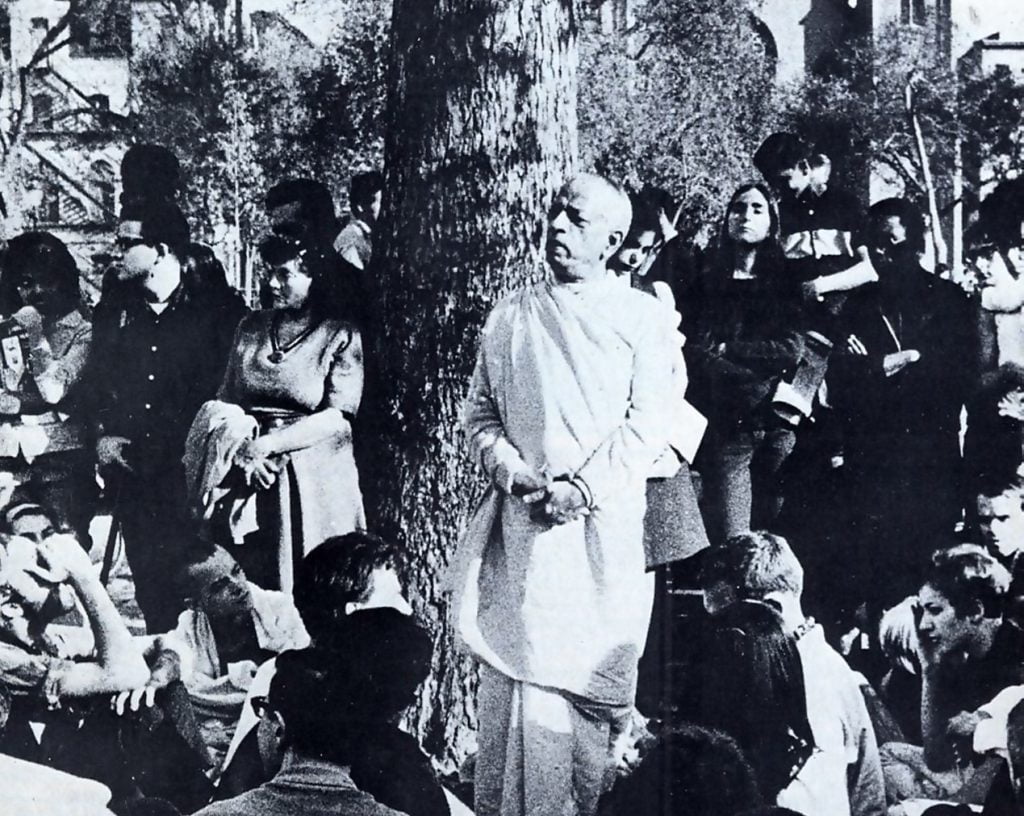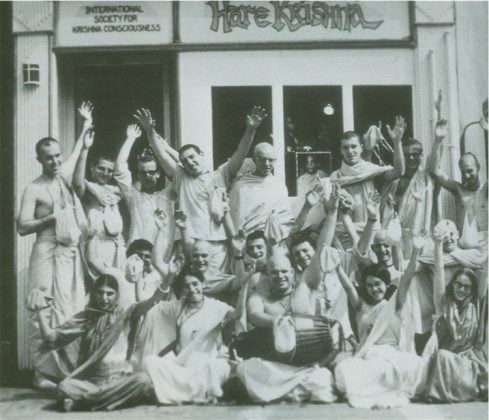Bob Dylan, the Hippies, and the Bhagavad Gita
By Sankirtana Das | Apr 07, 2024

In the 1950s, the Beatniks were a small cultural phenomenon. Their post-WWII poetry and literature of alienation didn’t interest enough of society to join them in their anti-establishment, anti-consumerist lifestyles. By the 1960s, the Beatnik culture segued into the hippie era. The early 60’s folk songs were able to attract many more young people than their predecessors. For many who came of age in the 60s, the new music both expressed and helped shape their perspectives. And no one was better at it than Bob Dylan, who was called “the voice of his generation.” Many of his songs – including “Blowing in the Wind,” “Times Are A-Changing,” “Masters of War,” “A Hard Rain’s a-Gonna Fall,” and “It’s Alright Ma (I’m Only Bleeding)” – became anthems for the counter-culture. Eventually, even college courses emerged to study Dylan’s poetry, and in 2016, he received the Nobel Prize for Literature.
In the latter 1960s, practically all the early followers of the Hare Krishna Movement came from the hippie community. These hippies, once inspired by Dylan’s songs, left the counter-culture and now became inspired by the teachings of Bhagavad Gita. Of course, devotees will say it was only by the causeless mercy of Srila Prabhupada, founder of the Krishna Movement in the West, that they became devotees. However, that reason will not suffice for sociologists. Academia, and people in general, will want to understand the stepping stones as to why hippies became attracted to Prabhupada and the teachings of the ancient Bhagavad Gita.
I must admit I was also a hippie living at the time in the counter-culture Mecca of New York’s Lower Eastside. It was also in this neighborhood that, in 1966, Prabhupada started the Krishna Movement in a modest storefront at 26 Second Avenue. The tiny store had previously been called Matchless Gifts, and Prabhupada decided to keep the name.
In this article, I want to focus on one of those stepping stones, Dylan’s “It’s Alright Ma (I’m Only Bleeding),” written in the fall of 1964 before Prabhupada arrived in America. It was an inspired song. Amazingly enough, a number of points from the transcendental teachings of the Bhagavad Gita are found in this song. However, it’s most unlikely that Dylan had read the Gita at that time. In 1973-74, Dylan visited several Krishna temples. I was there when he visited Chicago ISKCON, located in Evanston at the time. When Dylan was in the temple, I checked out his vehicle, and there were several copies of Srila Prabhupada’s books lying about, including “Bhagavad Gita As It Is.” In a February 1974 conversation with his disciples, Prabhupada acknowledged that Dylan was reading his books.
The rambling narrative of snippets Dylan strings together in “It’s Alright Ma (I’m Only Bleeding)” describes the hypocrisy, greed, shallowness, and violence of American culture. Howard Sounes, Dylan’s biographer, called the song a “grim masterpiece.” One of the famous lines – “He not busy being born is busy dying,” was even quoted by Jimmy Carter in his acceptance speech for his presidential nomination at the 1976 Democratic National Convention. This was actually one of Dylan’s favorite poems and one he often sang at concerts. “It’s Alright Ma (I’m Only Bleeding)” is a complex song. In a 2004 interview with 60 Minutes, Dylan said it was hard for him to comprehend how he wrote the song, which he accomplished in one sitting. He felt there was a “penetrating magic” to it.

Srila Prabhupada with young people in Tompkins Square Park in 1966. This photograph ran on the front page of the East Village Other, a popular underground newspaper.
The poem’s opening line, “Darkness at the break of noon,” immediately presents an ominous scene. The song juxtaposes a “handmade blade” and a “child’s balloon,” implying that everyone, from the guilty to the innocent, will be affected by the world’s condition. Listeners are warned that there is no sense in even trying to understand their dilemma.
By the end of the second stanza, Dylan explains there are two types of people: those busy being born and those busy dying. In Bhagavad Gita 2.69, Krishna explains it differently: “What is night for all beings is the time of awakening for the self-controlled; and the time of awakening for all beings is night for the introspective sage.” Both descriptions offer a sharp contrast between those seeking a true understanding of their condition and those lost and deceived in the pursuit of material happiness. If we are not interested in self-realization, we are considered asleep or dead to the goal of life. Prabhupada explains that the purpose of human life is to constantly seek our connection with Krishna, the Lord Within the Heart, at every moment and in every situation; to be alive and attentive to every moment – what Prabhupada calls Krishna Consciousness. Krishna confirms this in Gita 4.9: “One who knows the transcendental nature of My appearance and activities does not, upon leaving the body, take his birth again in this material world, but attains My eternal abode, O Arjuna.”
But what happens when we pursue a materialistic life? We are overwhelmed by constant desires. Temptations, Dylan explains, “fly out the door.” Our lust becomes rampant. Temptations are unleashed and turn into actions. And the ultimate end: we find ourselves “at war” both internally with our true spiritual interests, and externally, we become angry with anyone who threatens our goals. Krishna explains this progression in the Gita 2.62: “While contemplating the objects of the senses, a person develops attachment for them, and from such attachment lust develops, and from lust anger arises.” Soon, we are consumed by “waterfalls of pity,” and we discover ourselves to be just one of the masses who are confused and crying.
The song reveals that the masters of materialistic society only offer us disillusioned words, toy guns, and colorful trinkets; nothing of any real, lasting value or anything sacred. The Bhagavad Gita tells us to pursue a spiritual path if we want to understand our real identities and our real interests. Dylan asks, “Who can we trust: the preachers, our teachers, the president of the United States?” And he warns us that we’re tricked into thinking we’re the only ones who can do what’s never been done and the only ones who can win what’s never been won. Dylan tells us what we intuitively already know: no mundane solutions will ever satisfy us.
Shortly after that, Dylan hits upon a very important point:
“To keep it in your mind and not forget
That it is not he or she or them, or it
That you belong to.”
This is the first piece of transcendental information Krishna offers us in the Gita 2.12: “Never was there a time when I did not exist, nor you, nor all these kings; nor in the future shall any of us cease to be.” It’s something we all need to understand to be truly free, no matter what label we give to our bodies. We are not the material body, but we are the eternal spirit-soul (atma), temporarily inhabiting this mortal shell. It’s not uncommon for many of us to feel awkward no matter what body we inhabit. Krishna goes on to explain that the only way to conquer our insatiable hankerings and desires is to “know oneself to be transcendental to the material senses, mind, and intelligence” (3.43). Thus, those on the transcendental path steady the mind through meditation and spiritual intelligence, and we gradually come to understand our eternal selves and our eternal relationship with our most dear friend, Sri Krishna. Krishna explains (6.29), “A true yogī observes Me in all beings and also sees every being in Me.”
In the age we live in, the Kali-yuga, meditation on the holy name of God is essential to truly free the heart of all stress and anxieties. God’s numerous names are found in various traditions throughout the world. The devotees of the Vaishnava tradition meditate on the maha-mantra – Hare Krishna Hare Krishna Krishna Krishna Hare Hare / Hare Rama Hare Rama Rama Rama Hare Hare. This great prayer washes away all the stress, anxiety, and conditioning lodged in the heart.
Dylan observes that most people go through life despising their jobs and their destinies. They dwell on their petty jealousies, follow strict party lines, find someone to idolize, etc. And what happens? The people you come to idolize don’t help you to a higher consciousness but rather bring you down into the narrow hole they’re in. Naturally, we need to seek guidance from those who can elevate us, who don’t let their minds drag them into dark corners but whose minds are focused on goodness and transcendence. Krishna explains, “For him who has conquered the mind, the mind is the best of friends; but for one who has failed to do so, his mind will remain the greatest enemy” (Gita 6.6).
As the song concludes, Dylan reminds us that death is coming even as we think it won’t happen to us. And in the Gita 10.34, Krishna reminds us: “I am all-devouring death.” Dylan humorously ends his song, saying if people really knew his unconventional thoughts, “They’d probably put my head in a guillotine / But it’s Alright Ma, it’s life, and life only.”

Devotees outside of ISKCON’s first temple at 26 2nd Avenue in the East Village of Manhattan, NY.
By the arrangement of Paramatma, Krishna within our hearts, the teachings of the Bhagavad Gita are slipped in throughout “It’s Alright Ma (I’m Only Bleeding).” Unfortunately, Dylan’s song is not perfectly realized knowledge. The problems of worldly life are posed. Dylan doesn’t expect much hope from materialistic life. Yet, the song can give us insights into the challenges we face as we wander through this world of dualities: of names and labels, of success and failure, of repeated birth and death (samsara). We try to get ahead. We want to be acknowledged. We want to be happy and prosperous. But we repeatedly fall into difficulties and forget the real purpose of life.
Dylan offered us a serious look at the personal, political, and material problems in the world. In the process, many of us sought a deeper meaning and came to realize that marijuana and psychedelic drugs were a dead end. But was there an actual path forward, a real solution to the myriad dilemmas of life? At best the counter-culture poets and singers could only tell us, like the Beatles did, “All you need is love.”
But Srila Prabhupada’s presentation of Bhagavad Gita gives us a clear understanding of how to foster and grow that love. We come to understand who Krishna is, who we are, the nature of time and the material world, and our eternal relationship with the Lord Within the Heart. That spirituality is a holistic process. We learn how to implement a spiritual practice that will sustain and nurture us.
In a discussion on the philosophy of Kierkegaard, Prabhupada explains, “This is the basis of our Krishna consciousness movement. We are learning how to love God, and we are teaching the same principle to the whole world. If the love of God is taught by religion, that religion should be considered first-class – be it Christian, Hindu, Muslim, or whatever. The test of a religion is this: ‘Have the followers learned how to love God?’ God is the center of love, and since everything is God’s expansion, the lover of God is a lover of everyone. A lover of God does not discriminate…when you love God, you love everyone and everything.”

About our Author
Sankirtana Das, a disciple of Srila Prabhupada, is a longtime resident of the New Vrindaban Community and an award-winning author and storyteller. He sits on the board of directors for the Vedic Friends Association. At New Vrindaban, Sankirtana Das offers sacred storytelling and scheduled in-depth tours. He has a special PowerPoint presentation, “Why & How the Hare Krishna Movement Came to the West,” and also discusses his personal experiences as a 1960s hippie. For more info about his work, visit www.Mahabharata-Project.com.















